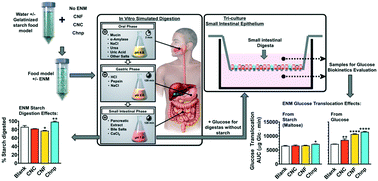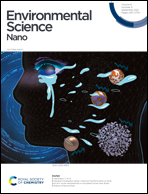Effects of ingested nanocellulose and nanochitosan materials on carbohydrate digestion and absorption in an in vitro small intestinal epithelium model†
Abstract
Nanoscale materials derived from natural biopolymers like cellulose and chitosan have many potentially useful agri-food and oral drug delivery applications. Because of their large and potentially bioactive surface areas and other unique physico-chemical properties, it is essential when evaluating their toxicological impact to assess potential effects on the digestion and absorption of co-ingested nutrients. Here, the effects of cellulose nanofibers (CNF), cellulose nanocrystals (CNC), and chitosan nanoparticles (Chnp) on the digestion and absorption of carbohydrates were studied. Starch digestion was assessed by measuring maltose released during simulated digestion of starch solutions. Glucose absorption was assessed by measuring translocation from the resulting digestas across an in vitro transwell tri-culture model of the small intestinal epithelium and calculating the area under the curve increase in absorbed glucose, analogous to the glycemic index. At 1% w/w, CNF and Chnp had small but significant effects (11% decrease and 14% increase, respectively) and CNC had no effect on starch hydrolysis during simulated digestion of a 1% w/w rice starch solution. In addition, at 2% w/w CNC had no effect on amylolysis in 1% solutions of either rice, corn, or wheat starch. Similarly, absorption of glucose from digestas of starch solutions (i.e., from maltose), was unaffected by 1% w/w CNF or CNC, but was slightly increased (10%, p < 0.05) by 1% Chnp, possibly due to the slightly higher maltose concentration in the Chnp-containing digestas. In contrast, all of the test materials caused sharp increases (∼1.2, 1.5, and 1.6 fold for CNC, CNF, and Chnp, respectively) in absorption of glucose from starch-free digestas spiked with free glucose at a concentration corresponding to complete hydrolysis of 1% w/w starch. The potential for ingested cellulose and chitosan nanomaterials to increase glucose absorption could have important health implications. Further studies are needed to elucidate the mechanisms underlying the observed increases and to evaluate the potential glycemic effects in an intact in vivo system.

- This article is part of the themed collection: Nano-bio interactions


 Please wait while we load your content...
Please wait while we load your content...